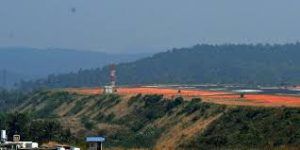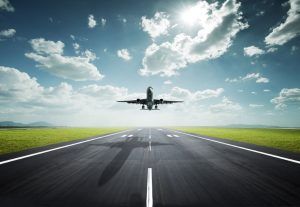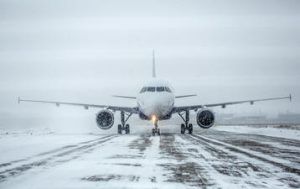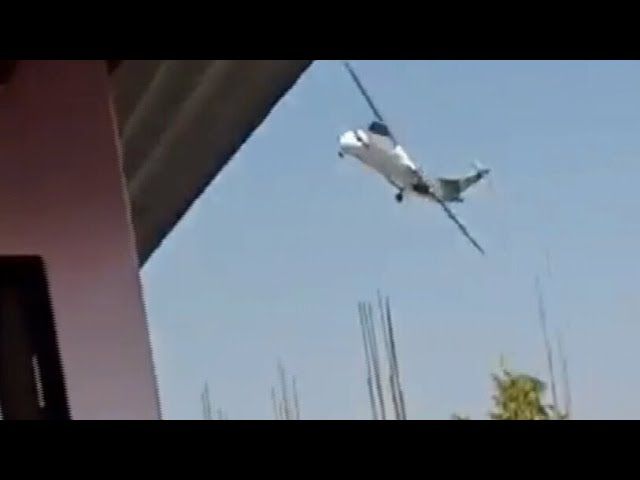SECURITY TODAY has compiled this article using information from IATA and other websites to help security professionals understand the basics of runway safety. This knowledge is essential for those directly involved in aviation security, as well as for those working with private air charters or overseeing private aircraft operations for organisations and top management functionaries.
The plane crash in Nepal that left 18 people dead has yet again put the spotlight on table-top runways that have been the site of major plane accidents across the world. Initial reports are also raising a question of the runway at the Kathmandu airport which may have had some issues that contributed to the crash.
Following the crash the focus has once again shifted to tabletop runways that have in past been the venues of several air crashes. Table-top runways are located on an elevated level than the surrounding terrain. This means there is a steep drop on one or more sides of the runway and this leaves a very slim margin of error for the pilot because if the plane overshoots the runway, it will crash down.
Five airports in India have table-top runways – Shimla, Calicut, Mangalore, Lengpui (Mizoram) and Pakyong (Sikkim). Of these, the airports in Kerala and Mangalore have seen big crashes in the past. On May 22, 2010, Air India Express Flight 812 from Dubai to Mangaluru crashed on landing and 158 passengers, including six crew members, were killed.
Ten years later, on August 7, 2020, another table-top runway became the site of a tragedy. The Air India Express flight from Dubai to Kozhikode was part of the Vande Bharat mission to bring back Indian nationals stranded due to Covid pandemic. The plane skidded off the table-top runway and crashed below. Nineteen passengers and both pilots died, but 169 others survived.
The Civil Aviation regulator, Directorate General of Civil Aviation, holds periodical reviews of table-top airports to ensure passenger safety. Back in 2022, an official of the DGCA had told the media that the objective behind the review was to prevent any unforeseen incidents and look for ways to make landings in these airports less challenging.
Portugal’s Madeira airport, which has a table-top runway, reported a crash back in 1977 when an Air Portugal Flight 425 overshot and crashed onto a beach, killing 131 people.
Even Nepal, which has a poor air travel safety record, has reported crashes involving table-top runways in the past. On May 27, 2017, a cargo plane crashed at the Tenzing-Hillary airport in Solukhumbu, which has such a runway.
 Since Tabletop runways are generally constructed on a hilly or an elevated terrain and a stiff task in poor weather conditions accurate landing is very important. Tabletops are very tricky and are challenging even for the best of pilots. In such conditions, the slightest lapse can lead to fatal crashes. A pilot with national carrier Air India Ltd. said “If visibility is poor and there are tailwinds, landing on a tabletop airport becomes a challenge.”
Since Tabletop runways are generally constructed on a hilly or an elevated terrain and a stiff task in poor weather conditions accurate landing is very important. Tabletops are very tricky and are challenging even for the best of pilots. In such conditions, the slightest lapse can lead to fatal crashes. A pilot with national carrier Air India Ltd. said “If visibility is poor and there are tailwinds, landing on a tabletop airport becomes a challenge.”
According to a senior Air India pilot “automation might not help in the case of tabletop runways. An optical illusion can also be the issue where the runway might seem to be nearer whereas it would be further away. Some pilots also stressed that there is not much of a buffer zone, unlike normal runways.
The safety concerns were first raised following the Air India Express crash in Mangalore in 2010 in which around 160 people were killed on board. The report of 2010 has cautioned of operations at such ‘critical airfields’. Certain airfields were classified by DGCA as critical which need a special qualification for the flight crew to undertake operations. There are several factors on which basis airfields are classified as critical including terrain, length of the runway, a predominance of inclement weather, etc.
Firstly, such runway design is like that they have dangerous starts and ends. Pilots need excellent training to land on them. They can be hazardous also, no matter the weather or time of day. Another reason can be that the way the runways line up with the horizon and edge of the mountain creates an optical illusion that hides the drop.
If pilots don’t have experience at an airport, they might misjudge the remaining length of the runway and accidentally overshoot. At these runways, aircraft coming to land need to be extra careful and ensure that they hit the exact mark to land that is not too early and also not too late.
Aviation experts have often also spoken at length about runway conditions being responsible for minor and major aircraft mishaps that have happened across the globe.
The condition of a runway is a critical factor that significantly impacts airport operations. As the primary surface for takeoff and landing, the condition of a runway directly affects the safety, efficiency, and capacity of an airport.
 Several factors can affect the condition of a runway, including weather conditions, regular wear and tear, maintenance activities, and other operational factors. The safety of aircraft operations is the top priority at airports. A deteriorating or poorly maintained runway can pose serious safety risks.
Several factors can affect the condition of a runway, including weather conditions, regular wear and tear, maintenance activities, and other operational factors. The safety of aircraft operations is the top priority at airports. A deteriorating or poorly maintained runway can pose serious safety risks.
For example, cracks, potholes, or uneven surfaces on the runway can damage aircraft tires, landing gears, or even cause accidents during takeoff or landing. Adverse weather conditions, such as snow, ice, or standing water on the runway, can also reduce friction and make it more challenging for aircraft to apply brakes and maintain control, increasing the risk of skidding or sliding off the runway.
The condition of a runway can also impact the operational efficiency of an airport. If a runway is closed or restricted due to poor condition, it can result in reduced capacity, delays, and disruptions to flight schedules.
This can cause flight cancellations, missed connections, and additional costs for airlines, passengers, and airport operators. Moreover, maintenance activities required to repair or rehabilitate a runway can also disrupt normal operations and lead to closures or restrictions, further affecting airport efficiency.
To communicate the condition of runways to pilots, airports and air traffic control agencies use a standardised ratings system. The International Civil Aviation Organization (ICAO) has established a globally recognized system called the Runway Condition Assessment Matrix (RCAM), which provides pilots with information about the condition of the runway surface.
The RCAM uses three parameters to assess runway conditions:
- Runway Surface Friction: Surface friction refers to the grip or traction of the runway surface. It is rated on a scale of 0.01 to 1.0, with higher values indicating better traction. A friction value of 0.40 or above is considered good, while a value of 0.25 or below is considered poor.
- Depth of Surface Contamination: This parameter refers to the depth of contaminants, such as water, snow, slush, or ice, on the runway surface. It is rated on a scale of 0 to 5, with higher values indicating greater contamination. A value of 0 indicates no contamination, while a value of 5 indicates a contaminated runway.
- Type of Surface Contamination: This parameter refers to the type of contaminants present on the runway surface. It is rated on a scale of 0 to 5, with higher values indicating more hazardous contaminants. For example, dry snow may have a lower rating than wet snow, and ice may have a higher rating than slush.
 Combining these three parameters, the provides a runway condition code ranging from 0 to 6, with 0 indicating a dry and clean runway, and 6 indicating a contaminated runway with poor surface friction.
Combining these three parameters, the provides a runway condition code ranging from 0 to 6, with 0 indicating a dry and clean runway, and 6 indicating a contaminated runway with poor surface friction.
Understanding the RCAM codes is essential for pilots to make informed decisions about runway operations. Here is a breakdown of the different RCAM codes and what they mean for pilots:
- RCAM Code 0: This code indicates a dry and clean runway with good surface friction, and no contaminants present. It is the optimal condition for runway operations and poses no significant risks to aircraft operations.
- RCAM Code 1: This code indicates a runway with reduced surface friction, usually due to light contaminants such as dampness, light snow, or light slush. Pilots should exercise caution and be prepared for reduced braking and traction on the runway.
- RCAM Code 2: This code indicates a runway with further reduced surface friction, usually due to moderate contaminants such as wet snow, slush, or ice patches. Pilots should use caution and adjust their landing and braking techniques accordingly.
- RCAM Code 3: This code indicates a runway with poor surface friction, usually due to significant contaminants such as deep snow, slush, or ice. Pilots should exercise extreme caution and consider using alternate runways if available.
- RCAM Code 4: This code indicates a runway with very poor surface friction, usually due to extensive contaminants or standing water. Pilots should avoid using runways with this condition, as it can pose significant risks to aircraft operations.
- RCAM Code 5: This code indicates a runway with contaminated surface conditions that are not suitable for aircraft operations. Pilots should not use runways with this condition and should seek alternate options.
Runway conditions play a crucial role in aviation safety, and pilots must understand the ratings system used to communicate runway conditions. The RCAM provides a standardised approach for airports and air traffic control agencies to assess and communicate runway conditions to pilots, helping them make informed decisions for safe and efficient operations.
Pilots should always be vigilant and follow proper procedures when operating on runways, considering the type and condition of the runway surface to ensure the safety of their aircraft, crew, and passengers. Decoding the mystery of runway conditions is a critical skill for every pilot, and staying informed and updated on runway conditions is paramount to safe aviation operations.
Runway Safety, including runway excursions, runway incursions, tail strikes, and hard landings, is a critical aspect of aviation operations, and reducing Runway Safety-related accidents remains one of the top priorities according to IATA.
IATA plays a crucial role in this domain by fostering collaboration among various stakeholders in the industry. Through joint efforts with its Member Airlines, Airports, Regulators, Air Navigation safety Providers, Aircraft Manufacturers, other International Organizations, etc, and by harnessing a data-driven approach, IATA seeks to develop and implement safety strategies, which are designed to mitigate risks associated with runway safety.
Analysis of accident data has identified that the “runway excursion” category, where the aircraft departs the runway during takeoff or landing, is the most common type of accident reported annually.
Runway excursion can result in loss of life, and injury to persons either on board the aircraft or on the ground. It can also lead to damage to aircraft, and airfield or off airfield equipment including other aircraft, or buildings struck by the aircraft.
Runway excursions occur while an aircraft is either taking off or landing. They can be attributed to one or multiple factors ranging from unstable approaches, failure to go around, and the condition of the runway. It is essential that all parties involved (such as Pilots, Air Traffic Controllers, Airport Authorities, Air Navigation service Providers) work together to mitigate the hazards that result in an accident.
The Global Runway Safety Action Plan (GRSAP) emerged through a collaborative effort with Runway Safety Partners and was launched during the 2017 Second Global Runway Safety Symposium. The GRASP offers a set of recommended actions tailored for various stakeholders involved in runway safety, including airports, aircraft manufacturers, operators, states, and Air Navigation Service Providers (ANSPs). The primary objective of the GRSAP is to reduce the global rate of runway excursions and runway incursions, thereby enhancing overall runway safety. The latest development in this collaboration is the release of the second edition of the GRSAP in February 2024.
IATA has been actively collaborating with various industry partners to enhance runway safety by addressing the risks associated with runway excursions, incursions, tail strikes and other events associated with runway safety. The development of the Global Action Plan for the Prevention of Runway Excursions (GAPPRE) and the Global Action Plan for the Prevention of Runway Incursions (GAPPRI) is evidence of a collaborative effort with IATA playing a crucial role in their review and validation process.
While investigations continue in the Nepal crash, runways across the globe will once again be in crosshairs. Not just tabletop but even normal runways to ensure they are worthy for an aircraft to jetspeed on it with minimal chances of a mishap.





